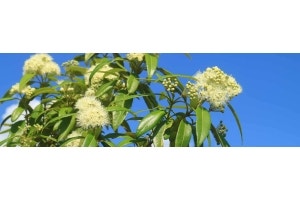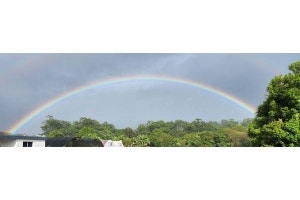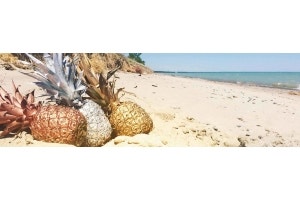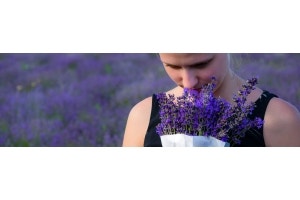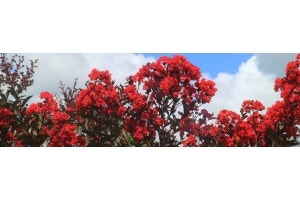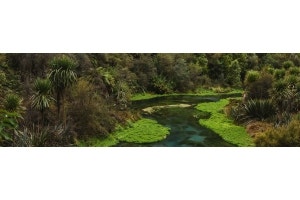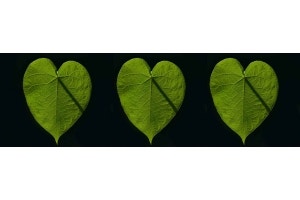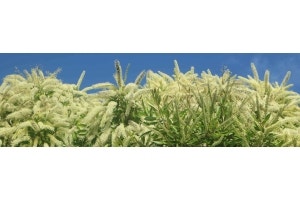
Silver-leaved plants have evolved their beautiful colouring for a range of reasons - and not only to look good! The silvery colour is a result of different adaptations that can help plants survive under tough conditions, where greener plants would struggle to thrive. Silver-grey leaves are brighter, like a mirror, helping to deflect scorching sunlight and reduce water evaporation.
That makes silver leaved plants : 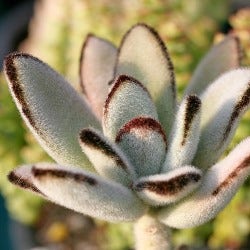 Some silver colouring is down to, well... down! A soft covering of tiny hairs, called tomentum, which adds a layer of insulation like a warm jumper, to regulate temperature and prevent leaves drying out.It's why one of the fuzziest of fluffy plants, the panda plant or chocolate soldier, has the botanic name Kalanchoe tomentosa - it's the most remarkable thing about this remarkable plant.
Some silver colouring is down to, well... down! A soft covering of tiny hairs, called tomentum, which adds a layer of insulation like a warm jumper, to regulate temperature and prevent leaves drying out.It's why one of the fuzziest of fluffy plants, the panda plant or chocolate soldier, has the botanic name Kalanchoe tomentosa - it's the most remarkable thing about this remarkable plant.
 Lamb's ears (Stachys) is the ultimate downy silver-leaf plant - it's almost like a pet! Try one on your office desk to alleviate workplace stress...
Silverbush (Convolvulus cneorum) has such satiny sheeny hairs on its leaves it looks like the most expensive velvet. The leaves are almost hidden by white trumpet flowers in warm months; the rest of the year it shines brightly in silver. Many members of the Helichrysum family have evolved to survive in harsh conditions, and the licorice plant (Helichrysum petiolare)has one of the most attractive evolutions for gardeners - small round leaves covered in soft velvety silver hairs. The hairs are denser on vulnerable new leaves - like many silver plants - giving an ombre shaded effect as the plant grows.Buddleia (Buddleja) Silver Anniversary and Lochinch both have soft silver new leaves which hold their colour well into maturity. Silver Anniversary's warm cream flowers match the leaf colour; Lochinch's lilac ones provide a gentle cool-toned contrast.
Lamb's ears (Stachys) is the ultimate downy silver-leaf plant - it's almost like a pet! Try one on your office desk to alleviate workplace stress...
Silverbush (Convolvulus cneorum) has such satiny sheeny hairs on its leaves it looks like the most expensive velvet. The leaves are almost hidden by white trumpet flowers in warm months; the rest of the year it shines brightly in silver. Many members of the Helichrysum family have evolved to survive in harsh conditions, and the licorice plant (Helichrysum petiolare)has one of the most attractive evolutions for gardeners - small round leaves covered in soft velvety silver hairs. The hairs are denser on vulnerable new leaves - like many silver plants - giving an ombre shaded effect as the plant grows.Buddleia (Buddleja) Silver Anniversary and Lochinch both have soft silver new leaves which hold their colour well into maturity. Silver Anniversary's warm cream flowers match the leaf colour; Lochinch's lilac ones provide a gentle cool-toned contrast.
 You can see that ombre effect more strongly on the leaves of the pewter plant (Strobilanthes). New leaves are densely covered in silver hairs; older leaves need only a light fringe to protect them. Cascading like a waterfall of silver coins, it also looks highly effective planted on the top of a pergola or over a balcony.And talking of coins, gold coin (Asteriscus) has developed its subtle silver hairs as an adaptation to its native Atlantic island homes - which makes it very comfortable in full sun and drying winds. Dymondia Silver Carpet which lives on the south African Cape coast uses the same technique on the underside of its narrow leaves.
You can see that ombre effect more strongly on the leaves of the pewter plant (Strobilanthes). New leaves are densely covered in silver hairs; older leaves need only a light fringe to protect them. Cascading like a waterfall of silver coins, it also looks highly effective planted on the top of a pergola or over a balcony.And talking of coins, gold coin (Asteriscus) has developed its subtle silver hairs as an adaptation to its native Atlantic island homes - which makes it very comfortable in full sun and drying winds. Dymondia Silver Carpet which lives on the south African Cape coast uses the same technique on the underside of its narrow leaves.
 Native Australian plants live in some of the toughest conditions on earth, and as a result they've also made themselves protective downy clothing. Yellow buttons (Chrysocephalum), downy zieria (Ziera), saltbush (Rhagodia) and emu bush (Eremophila) - like Kalbarri Carpet in the banner image at the top - are just a few of the many natives using this trick to hold in moisture and ward off harsh sunlight. They also have reduced the size of their leaves as much as possible, to slow down evaporation of precious water.
Native Australian plants live in some of the toughest conditions on earth, and as a result they've also made themselves protective downy clothing. Yellow buttons (Chrysocephalum), downy zieria (Ziera), saltbush (Rhagodia) and emu bush (Eremophila) - like Kalbarri Carpet in the banner image at the top - are just a few of the many natives using this trick to hold in moisture and ward off harsh sunlight. They also have reduced the size of their leaves as much as possible, to slow down evaporation of precious water.
 Silvery leaves are often narrower than green leaves. This is to reduce water loss, and minimise the surface area exposed to hot sun. Many Mediterranean 'Garrigue' plants - especially herbs like rosemary, thyme, oregano - have reduced their leaves as much as possible to reduce water loss in hot summers. This also helps intensify the oils in the leaves, making them super-tasty to us!
Cotton lavender (Santolina) is a little toughie, prepared for a harsh climate, having shrunk its leaves to little more than nubbins. It's even done away with the luxury of flower petals too, keeping only the yellow centres of each daisy flower to lure in the pollinators.
Silvery leaves are often narrower than green leaves. This is to reduce water loss, and minimise the surface area exposed to hot sun. Many Mediterranean 'Garrigue' plants - especially herbs like rosemary, thyme, oregano - have reduced their leaves as much as possible to reduce water loss in hot summers. This also helps intensify the oils in the leaves, making them super-tasty to us!
Cotton lavender (Santolina) is a little toughie, prepared for a harsh climate, having shrunk its leaves to little more than nubbins. It's even done away with the luxury of flower petals too, keeping only the yellow centres of each daisy flower to lure in the pollinators. Conifers don't often grown in hot sun, but they do grow in drying arctic winds - and the same adaptations that help desert plants survive droughts help conifers survive these winters. Juniper are valued in gardens for their fine foliage - most beautiful in this silvery-blue Pyramidalis variety.
Euphorbia is a huge and very diverse family of plants, with members growing in all kinds of situations around the globe, and with very different appearances as a result. You'd never take them for relatives!
Conifers don't often grown in hot sun, but they do grow in drying arctic winds - and the same adaptations that help desert plants survive droughts help conifers survive these winters. Juniper are valued in gardens for their fine foliage - most beautiful in this silvery-blue Pyramidalis variety.
Euphorbia is a huge and very diverse family of plants, with members growing in all kinds of situations around the globe, and with very different appearances as a result. You'd never take them for relatives!
One of those family members is the hedgehog euphorbia or fir spurge, a semi-succulent, which has developed slender silvery-blue leaves with a waxy coating to ward off sunshine and lock in moisture. The native Adenanthos or woolly bush - very fine of leaf - also thinks this is a neat solution to harsh conditions. Its silvery slender leaves are very soft and fine to the touch - another gorgeous sensory-garden plant! - and just as clever at holding onto precious water.Grasses grow great at the coast; those strong winds blow right through the fine leaves. Blue fescue (Festuca glauca) are super popular for coastal gardens - and they also grow well inland, in pots and planters, in herbaceous borders, in urban modern back yards... To turn up that silvery sexiness to the max, pick the variety 'Elijah Blue' which turns that steel blue colouring to ice white.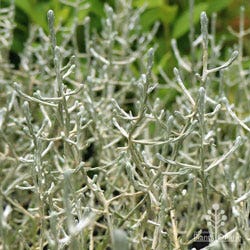 The final boss when it comes to this skinny-leaf water-reducing technique is our very own native silver cushion bush, Leucophyta brownii , an amazing-looking shrub that clings to coastal cliffs all along the southern states of Australia.
The final boss when it comes to this skinny-leaf water-reducing technique is our very own native silver cushion bush, Leucophyta brownii , an amazing-looking shrub that clings to coastal cliffs all along the southern states of Australia.  In hot dry sunlight, soft floppy leaves would shrivel and burn; tough and leathery leaves are far more resilient, ideal for challenging climate conditions.
Native callistemon know this; take a close look at the new leaf shoots in spring and you'll see many have a silvery-pink sheen and a stiffness to them which increases their resilience. The varieties Candy Pink (pictured),
Pink Champagne, and
Snow Burst will give you this shimmery leaf colour.
In hot dry sunlight, soft floppy leaves would shrivel and burn; tough and leathery leaves are far more resilient, ideal for challenging climate conditions.
Native callistemon know this; take a close look at the new leaf shoots in spring and you'll see many have a silvery-pink sheen and a stiffness to them which increases their resilience. The varieties Candy Pink (pictured),
Pink Champagne, and
Snow Burst will give you this shimmery leaf colour.
 Succulents are known for their ability to withstand harsh conditions; so it's no surprise many of them also have a silver colour all year round, like the striking Kalanchoe Silver Spoons and Quicksilver. Silver leaves are sometimes coated in a fine layer of wax - like sunscreen - to lock in valuable moisture. It's a solution many succulents use, often with a top layer of powder (called 'farina'), like highlighter over foundation, which adds to the silvery sparkle. aloe Quicksilver Haworthia Savanna, and many many Echeveria and Graptoveria succulents have waxy silver leaves, the perfect armour to fight off intense sunlight and drying heat.
Succulents are known for their ability to withstand harsh conditions; so it's no surprise many of them also have a silver colour all year round, like the striking Kalanchoe Silver Spoons and Quicksilver. Silver leaves are sometimes coated in a fine layer of wax - like sunscreen - to lock in valuable moisture. It's a solution many succulents use, often with a top layer of powder (called 'farina'), like highlighter over foundation, which adds to the silvery sparkle. aloe Quicksilver Haworthia Savanna, and many many Echeveria and Graptoveria succulents have waxy silver leaves, the perfect armour to fight off intense sunlight and drying heat.
- perfect for coastal gardens, with bright light and desiccating sea breezes
- ideal for inland and outback gardens, with hot sun and very little shade
- tailormade for urban gardens, where man-made surfaces raise temperatures, repel rainfall, and reflect bright light
Soft Strokeable Silver Plants
 Some silver colouring is down to, well... down! A soft covering of tiny hairs, called tomentum, which adds a layer of insulation like a warm jumper, to regulate temperature and prevent leaves drying out.It's why one of the fuzziest of fluffy plants, the panda plant or chocolate soldier, has the botanic name Kalanchoe tomentosa - it's the most remarkable thing about this remarkable plant.
Some silver colouring is down to, well... down! A soft covering of tiny hairs, called tomentum, which adds a layer of insulation like a warm jumper, to regulate temperature and prevent leaves drying out.It's why one of the fuzziest of fluffy plants, the panda plant or chocolate soldier, has the botanic name Kalanchoe tomentosa - it's the most remarkable thing about this remarkable plant.
Raindrops roll right off glossy smooth leaves, while the fine hairs on downy leaves cling onto every droplet of mist and morning dew in a dry climate. It's why some silver-leaf plants struggle in tropical gardens - there's too much of that rain for them to hang onto!
Many silver plants are this colour because they have a fine layer of soft hairs on their leaves - from the subtle suede-softness of buddleia and licorice plant, through the sheeny silky-soft silverbush and silver falls, to the positively baby-rabbit softness of lambs ears.Not only are silver-leaved plants like these perfect for planting in hot dry sunny places, that downy-velvet layer makes them perfect for sensory gardens too, where the pleasure comes from touch. Stroke them and you'll see what we mean!
 Lamb's ears (Stachys) is the ultimate downy silver-leaf plant - it's almost like a pet! Try one on your office desk to alleviate workplace stress...
Silverbush (Convolvulus cneorum) has such satiny sheeny hairs on its leaves it looks like the most expensive velvet. The leaves are almost hidden by white trumpet flowers in warm months; the rest of the year it shines brightly in silver. Many members of the Helichrysum family have evolved to survive in harsh conditions, and the licorice plant (Helichrysum petiolare)has one of the most attractive evolutions for gardeners - small round leaves covered in soft velvety silver hairs. The hairs are denser on vulnerable new leaves - like many silver plants - giving an ombre shaded effect as the plant grows.Buddleia (Buddleja) Silver Anniversary and Lochinch both have soft silver new leaves which hold their colour well into maturity. Silver Anniversary's warm cream flowers match the leaf colour; Lochinch's lilac ones provide a gentle cool-toned contrast.
Lamb's ears (Stachys) is the ultimate downy silver-leaf plant - it's almost like a pet! Try one on your office desk to alleviate workplace stress...
Silverbush (Convolvulus cneorum) has such satiny sheeny hairs on its leaves it looks like the most expensive velvet. The leaves are almost hidden by white trumpet flowers in warm months; the rest of the year it shines brightly in silver. Many members of the Helichrysum family have evolved to survive in harsh conditions, and the licorice plant (Helichrysum petiolare)has one of the most attractive evolutions for gardeners - small round leaves covered in soft velvety silver hairs. The hairs are denser on vulnerable new leaves - like many silver plants - giving an ombre shaded effect as the plant grows.Buddleia (Buddleja) Silver Anniversary and Lochinch both have soft silver new leaves which hold their colour well into maturity. Silver Anniversary's warm cream flowers match the leaf colour; Lochinch's lilac ones provide a gentle cool-toned contrast.
 You can see that ombre effect more strongly on the leaves of the pewter plant (Strobilanthes). New leaves are densely covered in silver hairs; older leaves need only a light fringe to protect them. Cascading like a waterfall of silver coins, it also looks highly effective planted on the top of a pergola or over a balcony.And talking of coins, gold coin (Asteriscus) has developed its subtle silver hairs as an adaptation to its native Atlantic island homes - which makes it very comfortable in full sun and drying winds. Dymondia Silver Carpet which lives on the south African Cape coast uses the same technique on the underside of its narrow leaves.
You can see that ombre effect more strongly on the leaves of the pewter plant (Strobilanthes). New leaves are densely covered in silver hairs; older leaves need only a light fringe to protect them. Cascading like a waterfall of silver coins, it also looks highly effective planted on the top of a pergola or over a balcony.And talking of coins, gold coin (Asteriscus) has developed its subtle silver hairs as an adaptation to its native Atlantic island homes - which makes it very comfortable in full sun and drying winds. Dymondia Silver Carpet which lives on the south African Cape coast uses the same technique on the underside of its narrow leaves.
Their southern African compatriots the brightly-coloured gazania have one or two members who've also caught on to this clever trick, and have swapped green leaves for grey ones - Silver Leaf and Talent varieties are particularly strongly silver in leaf colour thanks to their soft velvety leaves.Growing by the coast in the wild, NZ Christmas bush (Metrosideros) protect their new leaf shoots from the wind with fuzzy hairs - usually lime green, but in the case of this variety, Velvet Sky, they emerge silver-blue with shades of navy. It's a stunning effect!
 Native Australian plants live in some of the toughest conditions on earth, and as a result they've also made themselves protective downy clothing. Yellow buttons (Chrysocephalum), downy zieria (Ziera), saltbush (Rhagodia) and emu bush (Eremophila) - like Kalbarri Carpet in the banner image at the top - are just a few of the many natives using this trick to hold in moisture and ward off harsh sunlight. They also have reduced the size of their leaves as much as possible, to slow down evaporation of precious water.
Native Australian plants live in some of the toughest conditions on earth, and as a result they've also made themselves protective downy clothing. Yellow buttons (Chrysocephalum), downy zieria (Ziera), saltbush (Rhagodia) and emu bush (Eremophila) - like Kalbarri Carpet in the banner image at the top - are just a few of the many natives using this trick to hold in moisture and ward off harsh sunlight. They also have reduced the size of their leaves as much as possible, to slow down evaporation of precious water.
Skinny Slender Silver-Leaved Plants
 Silvery leaves are often narrower than green leaves. This is to reduce water loss, and minimise the surface area exposed to hot sun. Many Mediterranean 'Garrigue' plants - especially herbs like rosemary, thyme, oregano - have reduced their leaves as much as possible to reduce water loss in hot summers. This also helps intensify the oils in the leaves, making them super-tasty to us!
Cotton lavender (Santolina) is a little toughie, prepared for a harsh climate, having shrunk its leaves to little more than nubbins. It's even done away with the luxury of flower petals too, keeping only the yellow centres of each daisy flower to lure in the pollinators.
Silvery leaves are often narrower than green leaves. This is to reduce water loss, and minimise the surface area exposed to hot sun. Many Mediterranean 'Garrigue' plants - especially herbs like rosemary, thyme, oregano - have reduced their leaves as much as possible to reduce water loss in hot summers. This also helps intensify the oils in the leaves, making them super-tasty to us!
Cotton lavender (Santolina) is a little toughie, prepared for a harsh climate, having shrunk its leaves to little more than nubbins. It's even done away with the luxury of flower petals too, keeping only the yellow centres of each daisy flower to lure in the pollinators.True lavender (Lavandula) is just as resilient by the sea, those slender leaves giving nothing away to the environment. It's one reason silvery herbs like these dry so well - they have little water in their stems and leaves while they are growing.
Growing alongside cotton lavender in its native home, curry bush (Helichrysum) is known as "immortelle" - immortal - for its ability to withstand hot sun and drought, and to dry perfectly too.
From the southern regions of Africa, Eumorphia Silver Cloud shows that when Mother Nature finds a great solution to a problem, she uses it wherever possible. Tiny slender grey leaves, like the European herbs, help reduce water loss. This daisy has hung onto its soft white petals though - which makes it a very pretty garden plant for rockeries and balcony planters.
 Conifers don't often grown in hot sun, but they do grow in drying arctic winds - and the same adaptations that help desert plants survive droughts help conifers survive these winters. Juniper are valued in gardens for their fine foliage - most beautiful in this silvery-blue Pyramidalis variety.
Euphorbia is a huge and very diverse family of plants, with members growing in all kinds of situations around the globe, and with very different appearances as a result. You'd never take them for relatives!
Conifers don't often grown in hot sun, but they do grow in drying arctic winds - and the same adaptations that help desert plants survive droughts help conifers survive these winters. Juniper are valued in gardens for their fine foliage - most beautiful in this silvery-blue Pyramidalis variety.
Euphorbia is a huge and very diverse family of plants, with members growing in all kinds of situations around the globe, and with very different appearances as a result. You'd never take them for relatives! One of those family members is the hedgehog euphorbia or fir spurge, a semi-succulent, which has developed slender silvery-blue leaves with a waxy coating to ward off sunshine and lock in moisture. The native Adenanthos or woolly bush - very fine of leaf - also thinks this is a neat solution to harsh conditions. Its silvery slender leaves are very soft and fine to the touch - another gorgeous sensory-garden plant! - and just as clever at holding onto precious water.Grasses grow great at the coast; those strong winds blow right through the fine leaves. Blue fescue (Festuca glauca) are super popular for coastal gardens - and they also grow well inland, in pots and planters, in herbaceous borders, in urban modern back yards... To turn up that silvery sexiness to the max, pick the variety 'Elijah Blue' which turns that steel blue colouring to ice white.
 The final boss when it comes to this skinny-leaf water-reducing technique is our very own native silver cushion bush, Leucophyta brownii , an amazing-looking shrub that clings to coastal cliffs all along the southern states of Australia.
The final boss when it comes to this skinny-leaf water-reducing technique is our very own native silver cushion bush, Leucophyta brownii , an amazing-looking shrub that clings to coastal cliffs all along the southern states of Australia. It has reduced all its leaves to shiny silver-white needles : no waste or surplus, hyper-efficient and designed to maximise scarce resources. That bright metallic colour helps bounce back scorching sunlight too. With its space age good looks it looks like it grows on Mars - and with its clever adaptation to drought, heat, and wind, it probably could!
Tough-as Leathery Silver-Leaved Plants
 In hot dry sunlight, soft floppy leaves would shrivel and burn; tough and leathery leaves are far more resilient, ideal for challenging climate conditions.
Native callistemon know this; take a close look at the new leaf shoots in spring and you'll see many have a silvery-pink sheen and a stiffness to them which increases their resilience. The varieties Candy Pink (pictured),
Pink Champagne, and
Snow Burst will give you this shimmery leaf colour.
In hot dry sunlight, soft floppy leaves would shrivel and burn; tough and leathery leaves are far more resilient, ideal for challenging climate conditions.
Native callistemon know this; take a close look at the new leaf shoots in spring and you'll see many have a silvery-pink sheen and a stiffness to them which increases their resilience. The varieties Candy Pink (pictured),
Pink Champagne, and
Snow Burst will give you this shimmery leaf colour.
The uber-plant when it comes to water use, airplants (Tillandsia) can survive on the mist in the air - their stiff, waxy-coated leaves are masters at retaining every previous droplet of H20.Eucalypts are no slouches at this either. Because new young leaves need more protection than tougher older leaves, you'll often see a change in colour and even leaf shape between the young and old leaves of eucalypts; annual hard pruning will give you more fresh young silvery stems.If we're talking about experts in surviving harsh dry hot conditions, using tough leathery leaves, we can't go past the venerable olive. For thousands of years they've been providing valuable shade to desert sheep, biblical goats, and our nomadic early ancestors. Many of those ancient olive trees are still alive today, testament to how effective this silvery solution is when it comes to staying alive.
Silver-Leaved Succulents
 Succulents are known for their ability to withstand harsh conditions; so it's no surprise many of them also have a silver colour all year round, like the striking Kalanchoe Silver Spoons and Quicksilver. Silver leaves are sometimes coated in a fine layer of wax - like sunscreen - to lock in valuable moisture. It's a solution many succulents use, often with a top layer of powder (called 'farina'), like highlighter over foundation, which adds to the silvery sparkle. aloe Quicksilver Haworthia Savanna, and many many Echeveria and Graptoveria succulents have waxy silver leaves, the perfect armour to fight off intense sunlight and drying heat.
Succulents are known for their ability to withstand harsh conditions; so it's no surprise many of them also have a silver colour all year round, like the striking Kalanchoe Silver Spoons and Quicksilver. Silver leaves are sometimes coated in a fine layer of wax - like sunscreen - to lock in valuable moisture. It's a solution many succulents use, often with a top layer of powder (called 'farina'), like highlighter over foundation, which adds to the silvery sparkle. aloe Quicksilver Haworthia Savanna, and many many Echeveria and Graptoveria succulents have waxy silver leaves, the perfect armour to fight off intense sunlight and drying heat.
So you see, when you're gardening in harsh climates, silver-leaved plants can help you create your dream garden. They look stunning planted together, and very dramatic when paired with dark-leaved plants. Add vibrant flowers for lots of visual excitement, or keep things cool and elegant with gentle pastel blooms. Silver plants are endlessly versatile!
























